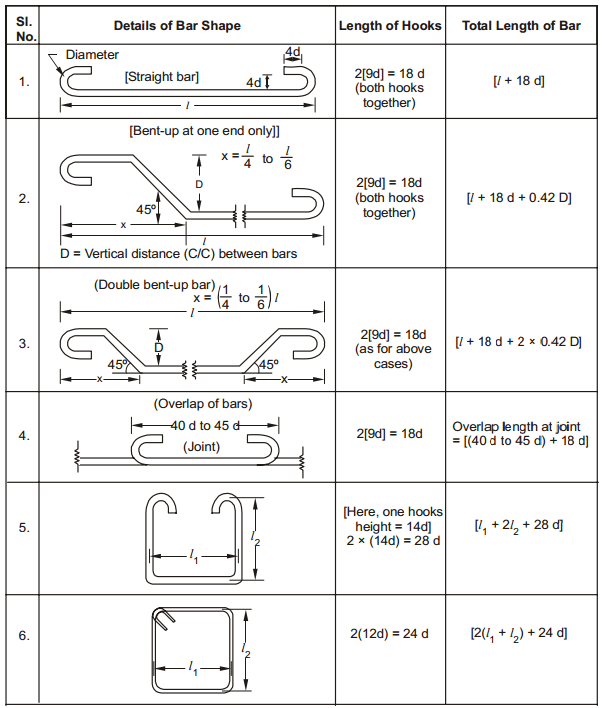How to Calculate Cement Sand Aggregate in Concrete?
Question
Hi Friends please tell me about cement concrete calculation.
Volume of concrete = 4000 ft3
Ratio of concrete = 1:2:4
Reinforcement Steel Quantity = 3 ton
Volume of concrete = 4000 ft3
Ratio of concrete = 1:2:4
Reinforcement Steel Quantity = 3 ton
Preparation of Bar Bending Schedule
Bar bending schedule (or schedule of bars) is a list of reinforcement bars, vis-à-vis, a given RCC work item, and is presented in a tabular form for easy visual reference. This table summarizes all the needed particulars of bars – diameter, shape of bending, length of each bent and straight portions, angles of bending, total length of each bar, and number of each type of bar. This information is a great help in preparing an estimate of quantities.
Figure 1 depicts the shape and proportions of hooks and bends in the reinforcement bars – these are standard proportions that are adhered to:
(a) Length of one hook = (4d ) + [(4d+ d )] – where, (4d+ d ) refers to the curved portion = 9d.
(b) The additional length (la) that is introduced in the simple, straight end-to-end length of a reinforcement bar due to being bent up at  say 30o to 60o, but it is generally 45o) = l1 – l2 = la
say 30o to 60o, but it is generally 45o) = l1 – l2 = la
Where,

Fig: Hooks and bends in Reinforcement
Giving different values to  respectively), we get different values of la, as tabulated below:
respectively), we get different values of la, as tabulated below:

Figure 2 presents the procedure to arrive at the length of hooks and the total length of a given steel reinforcement.

Fig: Typical Bar Bending Schedule
ESTIMATION METHODS OF BUILDING WORKS
ESTIMATION METHODS OF BUILDING WORKS
The estimation of building quantities like earth work, foundation concrete, brickwork in plinth and super structure etc., can be workout by any of following two methods:
a) Long wall – short wall method
b) Centre line method.
c) Partly centre line and short wall method.

a) Long wall-short wall method:
In this method, the wall along the length of room is considered to be long wall while the wall perpendicular to long wall is said to be short wall. To get the length of long wall or short wall, calculate first the centre line lengths of individual walls. Then the length of long wall, (out to out) may be calculated after adding half breadth at each end to its centre line length. Thus the length of short wall measured into in and may be found by deducting half breadth from its centre line length at each end. The length of long wall usually decreases from earth work to brick work in super structure while the short wall increases. These lengths are multiplied by breadth and depth to get quantities.
b) Centre line method:
This method is suitable for walls of similar cross sections. Here the total centre line length is multiplied by breadth and depth of respective item to get the total quantity at a time. When cross walls or partitions or verandah walls join with main wall, the centre line length gets reduced by half of breadth for each junction. Such junction or joints are studied carefully while calculating total centre line length. The estimates prepared by this method are most accurate and quick.
c) Partly centre line and partly cross wall method:
This method is adopted when external (i.e., around the building) wall is of one thickness and the internal walls having different thicknesses. In such cases, centre line method is applied to external walls and long wall-short wall method is used to internal walls. This method suits for different thicknesses walls and different level of foundations. Because of this reason, all Engineering departments are practicing this method.
Data required for RCC Rate Analysis:
How to Calculate Labor & Reinforcement for 1m3 RCC column Work in detail ?
Estimation of Reinforcement Quantity in RCC Structure
Methods of Reinforcement Quantity Estimation
Method-1 for Reinforcement Estimation
Method-2 for Reinforcement Estimation
Method-3 for Reinforcement Estimation: